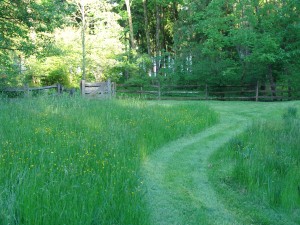Cooler temperatures and lower humidity and (thank goodness) some rain have come along with the start of fall this year. On a recent trip downstate, I saw sweeps of yellow from sweet goldenrod (Solidago odora)—our state herb. Goldenrod often gets a bad rap as the cause of fall allergies. In fact, goldenrod pollen is extremely heavy. It is pollinated by bees, butterflies, moths etc., but not by wind. It blooms at the same time as the inconspicuously green-flowered ragweed. Ragweed has light pollen, is wind-pollinated and is the most likely cause of many fall allergies. Contributing to the roadside yellow were also tickseed sunflower (Polylepis bidens) and swamp sunflower (Helianthus angustifolius). Warm season grasses, switchgrass (Panicum virgatum), Indiangrass (Sorghastrum nutans) and little bluestem (Schizycharium scoparium) are also blooming in great sweeps along our roadways. Fall is the season in which Delaware’s native vegetation shines. Along Route 1, groundsel bush (Baccharis halmifolia) is poised to burst into bloom with white fleecy flowers. Soon our native sumacs (Rhus typhina, Rhus copallina, Rhus glabra and Rhus aromatica) will turn bright red and make a great combination with groundsel bush. The first fall color we see in Delaware is the crimson color of black gum (Nyssa sylvatica). At the northern end of Route 1, the black gums are just starting to show hints of red.
If you want to do more than view our beautiful fall landscape, there are plenty gardening activities best accomplished in the fall. Fall, once we get some consistent rainfall, is a great time to plant most trees and shrubs. Trees and shrubs put energy into root growth in fall, so plants quickly become established in their new sites. One exception is with evergreens, which do not grow many roots as the weather gets cooler and the day length shorter, so avoid planting evergreens in the fall. Perennials can be planted in fall, but if you are planting very small plants or plugs, it is best to wait until spring. Alternate freezing and thawing during winter, pushes small plants out of the ground.
Fall is the best time to renovate your lawn. Start by evaluating how you use your lawn. Where do you need circulation? Play areas? Gathering spaces? Or green carpet to unify the scene? If lawn is not serving a purpose, get rid of it. Allow it to become a meadow or forest; or plant landscape beds or vegetable gardens in place of unused lawn. For those areas you do use, a thick, dense lawn will keep the weeds out and serve the intended purpose fully. Grass seed requires good contact with the soil to germinate. If you are over-seeding a relatively weed-free lawn, use a hard rake or core cultivator to expose soil before spreading the new seed. If you are renovating a poor quality lawn, it is best to kill the existing vegetation before seeding. You can smother the existing grass and weeds with black plastic, but if the area is large and full of perennial weeds, it will be more effective to use an herbicide, such as glyphosate. Take a soil sample to determine pH and nutrient deficiencies. Correct pH with lime and add nutrients following the recommendations of the soil test. Next core aerate or till to expose soil. Then spread grass seed. Turf type tall fescue is the preferred grass for all of Delaware. It is drought tolerant and tough enough to withstand modest play and traffic. Cover your newly seeded lawn area with a light layer of straw or salt hay to help keep the soil moist. Water frequently (daily at first) until the grass becomes established. Cut when the grass reaches 3-4 inches with a sharp mower blade. Dull mower blades may pull the seedling out of the soil instead of making a clean cut. Fertilize again once grass is established, usually by mid-fall.



